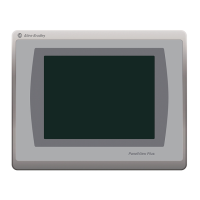
Do you have a question about the Rockwell Automation Allen-Bradley PanelView Plus 7 and is the answer not in the manual?
| Display Type | TFT LCD |
|---|---|
| Touch Screen | Yes |
| Power Supply | 24V DC |
| Memory | 512 MB RAM |
| Touch Technology | Resistive |
| Operating System | Windows Embedded Compact |
| Communication Ports | Ethernet, USB, Serial |
| Operating Temperature | 0°C to 50°C |
| Enclosure Rating | NEMA 4X |
| Display Size | 7 inches |
Explains symbols and warnings for hazards like explosion, shock, and burn.
Introduction to the operator interface devices that monitor and control automation systems.
Details the fixed hardware configurations, display sizes, and operator input options.
Explains touch screen gestures, keypad layout, and function keys for user interaction.
Lists supported software like FactoryTalk View ME Station, Studio, and ViewPoint.
Compares Series A (Windows CE) and Series B (Windows 10 IoT Core) operating systems.
Explains the difference between open and closed desktop environments for Series A terminals.
Specifies the terminal's actions on startup: launch application, configuration mode, or Windows desktop.
Details EtherNet/IP communication using embedded switch, supporting DLR, linear, or star topologies.
Provides a breakdown of the components and options within the product catalog numbers.
Details product selections based on touch, key, display, Ethernet, power, and memory.
Lists protective overlays, power supplies, terminal blocks, mounting hardware, and SD cards.
Information on recommended Ethernet cables for network connectivity.
Information for using equipment in hazardous locations, including warnings and temperature codes.
Guidance on terminal mounting height, lighting, and angles for optimal operation.
Specifies minimum clearances required around the terminal for ventilation and cabling.
Requirements for panels used for mounting terminals, including thickness and surface flatness.
Provides specific cutout dimensions for various terminal sizes for panel mounting.
Instructions on preparing the panel and using mounting levers for secure terminal installation.
Step-by-step guide for installing the aluminum terminal into a panel cutout using mounting levers.
Step-by-step guide for installing the stainless steel terminal using mounting clips.
Recommendations for maximizing field life and display performance in outdoor environments.
Procedure for removing and replacing the three-pin terminal block for power connections.
Details power ratings and connection steps for DC power supplies, including safety precautions.
Details power ratings and connection steps for AC power supplies, including safety precautions.
Explains connecting to an EtherNet/IP network using Ethernet ports and supported topologies.
Guide for the first-time startup sequence and launching FactoryTalk View ME Station in Configuration mode.
Steps for initial startup of Series B terminals, including touch screen calibration.
Runtime environment for configuring startup, loading applications, adjusting settings, and accessing desktop.
Adjustable settings not specific to applications, covering alarms, display, file management, and more.
Details the controls and usage of the on-screen keyboard for data entry fields.
Instructions for loading .mer application files from storage and running them on the terminal.
How to allow or restrict desktop access, set passwords, and manage access for Series A terminals.
Specifies terminal actions on startup or reset, like disabling FactoryTalk View ME Station.
Configures communication information for applications and controllers using FactoryTalk Linx software.
Modifies terminal's Ethernet information: IP address, device name, port configuration for network topologies.
Instructions for viewing or manually entering an IP address, and configuring DHCP settings.
Allows changing the Ethernet network's data transmission rate and mode (Auto or manual).
Configures Name Servers addresses for the EtherNet/IP network adapter, automatically assigned if DHCP is enabled.
Enables or disables Ethernet ports for network configuration and topology settings (DLR, star, linear).
Accesses network data to view properties, status, and topology information for troubleshooting.
Sets a unique name and description for the terminal to identify it on the network.
Copies FactoryTalk View ME application files or font files between storage and the terminal.
Deletes application .mer files or font files from nonvolatile memory, USB drive, or SD card.
Deletes log files, alarm history, and alarm status files from the System Default location.
Adjusts display intensity, configures screen saver, and enables/disables the screen cursor.
Adjusts backlight intensity in 10% increments from 0-100% for runtime operations.
Configures screen saver idle time, brightness, and enables/disables the screen saver image.
Allows enabling or disabling the visible cursor on the display.
Configures settings for keypad, touch screen, attached keyboard/mouse, and string entry popups.
Adjusts settings for keys on the terminal or an attached keyboard, such as repeat rate and delay.
Recalibrates the touch screen if it is not responding correctly to taps.
Sets and tests the sensitivity of both speed and physical distance between touch screen presses.
Allows using a string popup for character input instead of the popup keyboard or input panel.
Changes the popup input color settings for keypad, keyboard, or character input.
Configures settings to print displays, alarm messages, or diagnostic messages from applications.
Logs diagnostics to a remote computer for troubleshooting and configures message routing.
Periodically checks integrity of .mer application and runtime files; views and clears logs.
Displays warnings, errors, and events logged by the terminal; allows clearing the log.
Configures whether the alarm display closes or remains open when an alarm is acknowledged.
View terminal and firmware revision information, hardware status, and system properties.
Displays read-only information like power on time, processor temperature, battery voltage, and memory usage.
View firmware and version info for installed components and access technical support information.
Change the date, time, time zone, and regional settings for terminal operations.
View or modify the terminal's current time zone, adjusting time and date to match.
Adjusts the date on the terminal, allowing changes to Year, Month, and Day values.
Adjusts the time on the terminal, allowing changes to Hour, Minute, and Seconds values.
Change format for dates, times, and numerics to match country/region standards; select language.
Changes the decimal separator used in numeric formats for the selected language.
Modifies the time format for the selected language, adjusting sample formats and display.
Changes the short date format and the character used between date elements.
Changes the long date format for the selected language, updating sample dates and elements.
Allows selection of KEPServer drivers for Series B terminals (Series C for Stainless Steel terminals).
Import and update certificates for Series B terminals using the Control Panel.
Details the features of the Windows CE 6.0 OS, including command shell, file viewers, and network interface.
Lists applications supported by the Windows CE OS, such as .NET Compact Framework and C++ libraries.
Highlights scripting features supported by the Windows CE OS, including Batch/Command, CS-Script, and JScript.
Details network features supported by Windows CE 6.0, such as Winsock, ipconfig, and LAN support.
Lists servers supported by Windows CE 6.0, including Web, FTP, UPnP, File, VNC, and ViewPoint servers.
Lists additional desktop applications supported, like Internet Explorer, Adobe Flash, and Microsoft Office viewers.
Accessing and navigating folders containing items specific to the PanelView Plus 7 Performance platform.
Accessing the Start menu, device IP, language, time, input panels, and open programs from the taskbar.
Using different input panels from the taskbar or control panel for data entry.
Viewing and configuring system and terminal settings, monitoring performance, and calibrating touch screen.
Backing up the current system image and restoring it to the terminal or other HMI devices.
Controlling desktop background, appearance, backlight intensity, and screen saver settings.
Enabling or disabling the visible cursor on the display.
Rotating the screen orientation on the terminal and recalibrating the touch screen.
Provides continuous voltage, temperature, and load information for the terminal.
Shows all processes running on the terminal and their memory usage.
Displays warnings, errors, and events logged by the terminal; allows viewing and clearing logs.
Provides visual status and readings for battery voltage and logic board temperature.
Changes the logo appearing on the splash screen and the default screen saver image.
Creates NT LAN Manager (NTLM) user accounts for authenticating client connections.
Enables or disables supported servers like ViewPoint, File Server, and VNC Server.
Configures settings for VNC, FTP, web, Kepware, and file server activities over Ethernet.
Sets up VNC server for remote viewing and control, including password protection and view-only access.
Configures settings for HTTP web activities, including admin users, authentication, and log file directory.
Defines settings for exchanging files over a network using FTP, including security and authentication.
Allows shared access to files, printers, and serial ports between computers on a network.
Allows selection of Kepware communication drivers for connected devices.
Provides tabs to view and set system-wide properties for your terminal.
Sets startup options for showing battery warnings, launching as open/closed system, or configuring Ethernet ports.
Lists features of the Windows 10 IoT Core OS, including VNC Server, PDF reader, and Microsoft Edge.
Describes functionality available from the Control Panel, accessed via FactoryTalk View ME Station.
Explains icons in the main Menu that expand the menu bar for Control Panel options.
Describes navigation bar icons displayed on Control Panel screens for moving between screens.
Displays applications available on the terminal, including Web Browser, Notifications, and File Explorer.
Displays name, network, and version information about the PanelView terminal.
Using the Microsoft Edge browser to view web pages and PDFs; setting the default homepage.
Manages the administrator password used for services, SFTP, and file server access.
Selects application page, homepage, and sets tile size and color for terminal display.
Sets terminal language, soft keyboard language, and time zone.
Displays information about direct and Wi-Fi connections, and network properties.
Obtains updates for the operating system and applications; switches to firmware update mode.
Allows choosing to restart or shut down the terminal.
Recalibrates the touch screen if the device does not respond appropriately to taps.
Specifies whether to access various file servers like ViewPoint, File Server, and VNC Server.
Lets you select which event logs to generate for your terminal, such as Application, System, or WinCE logs.
Details the USB 2.0 and 3.0 host ports, their pinout, power load, and precautions for use.
Instructions for connecting and configuring USB printers, including plug-and-play and manual installation.
Guidance on inserting SD cards into the slot for extra storage, including lock status and orientation.
Connects speakers or audio amplifiers for alarms and video playback, with impedance and output power details.
Procedure for replacing the lithium battery for real-time clock and static RAM backup power.
Applies an overlay to protect the touch screen and keys from scratches, dust, and chemicals.
Steps to replace the blue hygienic gasket for stainless steel terminals, including cleaning and alignment.
Explains firmware components packaged as XIP regions and their update process.
Steps to download firmware installation packages from Rockwell Automation website.
Details methods for updating terminal firmware using the wizard via update card or network connection.
Procedure to upgrade firmware using a USB drive or SD card as a firmware update card.
Updates firmware via a direct network connection using Firmware Upgrade Wizard and FactoryTalk Linx.
Instructions for updating firmware on Series B terminals using USB storage or ControlFLASH.
Updates DLR Network Switch firmware for Series B terminals using Control Flash.
Accessing terminal system information via FactoryTalk View ME Station runtime or Hardware Monitor.
Explains the STS (green) and ERR (red) indicators for terminal status and fault identification.
Accessing network status from the system tray and dialog box for Series A terminals.
Troubleshooting steps for common causes when the terminal fails to start normally.
Troubleshooting steps for intermittent terminal restarts, including power wiring and temperature issues.
Diagnosing and resolving issues with touch screen response, calibration, and multiple input elements.
Addressing display problems like darkening, dimming, or unreadable screens, including safety precautions.
Tips for isolating Ethernet anomalies, including invalid IP addresses and poor cable connections.
Troubleshooting slow response times, checking application screens, controller feedback, and network performance.
Information on terminal material resistance to chemicals and potential discoloration.
Instructions for cleaning the display using a sponge or soft cloth, and avoiding water spots.
Steps to remove paint or grease from the bezel using isopropyl alcohol or soap solution.
Precautions for cleaning the terminal during equipment wash downs, avoiding high-pressure washers.
Ensuring the terminal is properly secured and protected when shipping the enclosure.
Procedures for starting system in Maintenance Mode for diagnostics and repairs.
Entering maintenance mode on Series B terminals via back button or Windows Control Panel.
Lists TrueType fonts pre-installed on terminals; explains loading additional fonts.
Lists languages supported in Machine Edition (ME) Station for Series A and Series B terminals.
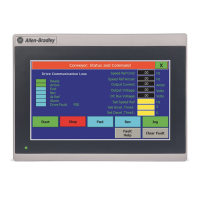
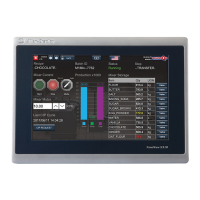
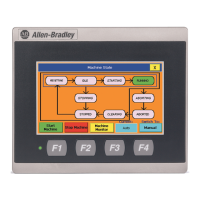
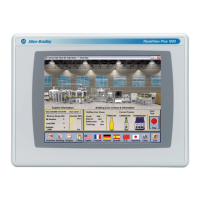
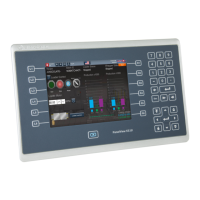



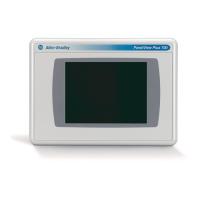
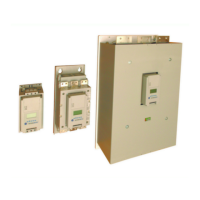

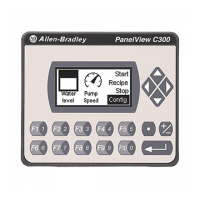
